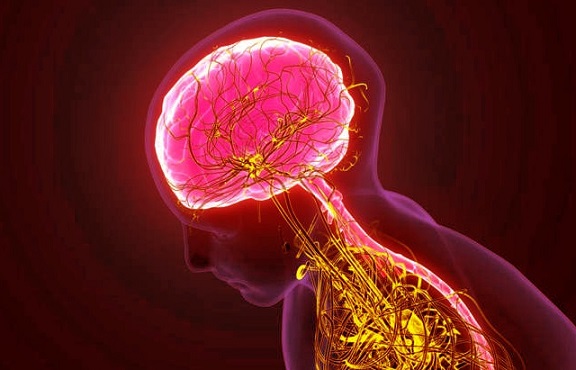COVID-19 Linked Nerve Damage Disorder Leaves Thousands Struggling with Strange Symptoms
Nikhil Prasad Fact checked by:Thailand Medical News Team Jun 16, 2025 6 months, 3 days, 3 hours, 20 minutes ago
Thailand Medical News: In recent years, as COVID-19 swept across the globe, millions have recovered from the initial infection—but a growing number of survivors are now facing a strange and debilitating condition known as post-COVID dysautonomia. This often-overlooked syndrome is emerging as a hidden crisis within the broader phenomenon of Long COVID, impacting the autonomic nervous system, which controls critical involuntary functions such as heart rate, digestion, and blood pressure.
 COVID-19 Linked Nerve Damage Disorder Leaves Thousands Struggling with Strange Symptoms
COVID-19 Linked Nerve Damage Disorder Leaves Thousands Struggling with Strange Symptoms
A new comprehensive narrative review by Brendan Jones from Kansas City University in Missouri, USA, has brought post-COVID dysautonomia into sharper focus. Drawing from a wide array of published research between 2020 and 2025, this
Thailand Medical News report highlights how the condition is triggered by the virus and manifests in diverse ways—from dizziness and racing heart to brain fog and gut problems. The review not only explores how these symptoms develop but also proposes emerging strategies to manage the condition, though definitive treatments remain elusive.
The Body’s Automatic System Under Attack
The autonomic nervous system normally operates silently in the background, ensuring that basic life functions like blood circulation, body temperature, and digestion run smoothly. But in patients with post-COVID dysautonomia, this balance is disrupted. Up to 30% of individuals suffering from Long COVID experience signs of autonomic dysfunction, most notably a condition called POTS, or postural orthostatic tachycardia syndrome, which is marked by a dramatic rise in heart rate when standing.
Jones’ analysis identifies several possible biological causes for this dysfunction. These include immune system misfires where the body produces antibodies that mistakenly attack receptors involved in heart and nerve signaling; persistent inflammation of the nervous system; damage to the vagus nerve (which plays a key role in controlling heart rate and digestion); injury to the lining of blood vessels; and even lingering viral material hiding inside the body. All these factors together may lead to a cascade of systemic problems that mimic other chronic conditions like chronic fatigue syndrome.
Debilitating Symptoms That Are Often Dismissed
Patients report a wide range of symptoms that can severely interfere with daily life. These include:
-Lightheadedness and fainting when standing
-Rapid heart rate
-Crushing fatigue, especially after physical activity
-Cognitive difficulties, often referred to as “brain fog”
-Stomach discomfort, including nausea and bloating
-Sensitivity to temperature
-Sleep disturbances
What’s particularly striking is
that these symptoms tend to affect younger women more than any other group, mirroring patterns seen in POTS even before the pandemic.
How Doctors Are Diagnosing and Treating It
Diagnosing post-COVID dysautonomia is no simple task. There’s no single blood test or scan to confirm it. Doctors rely heavily on a patient’s medical history, heart rate and blood pressure measurements taken in different positions, and tilt-table testing. Some patients may also undergo specialized tests to assess sweating and nerve function. Biomarkers, such as antibodies to certain nerve receptors, are still being researched and are not yet widely available for clinical use.
When it comes to treatment, a personalized, multi-pronged approach is usually necessary. Non-drug strategies include increasing fluid and salt intake, wearing compression garments, and starting gentle exercise like recumbent biking to slowly recondition the body. Medications such as beta-blockers (to slow the heart), midodrine (to raise blood pressure), or pyridostigmine (to improve nerve signaling) are sometimes used to target specific symptoms. However, no cure exists, and many patients report only partial relief.
Many Questions Remain Unanswered
Despite increasing recognition, post-COVID dysautonomia remains shrouded in mystery. Scientists still don’t fully understand why some people are more vulnerable than others, why symptoms vary so widely, or whether the condition is more immune-driven or nerve-centered. There’s also significant overlap with other chronic post-viral illnesses, which makes diagnosis and treatment even more complicated.
Looking Ahead
The study stresses the urgent need for more targeted research. This includes long-term studies following patients over time, better biological markers to detect and track the disease, and new clinical trials to test both drug-based and rehabilitation therapies. Brain scans and wearable devices may also play a growing role in understanding how the disorder develops and progresses.
In conclusion, post-COVID dysautonomia represents a major post-pandemic health challenge. While its root causes appear to be multifactorial—ranging from autoimmune responses to viral persistence—the resulting symptoms can be life-altering. With no definitive treatment yet available, sufferers often feel trapped in bodies that no longer cooperate. The medical community must prioritize research and collaboration to better diagnose, treat, and support this growing population of Long COVID patients.
The study findings were published on a preprint server and are currently being peer reviewed.
https://www.preprints.org/manuscript/202506.0584/v1
For the latest COVID-19 News, keep on logging to
Thailand Medical News.
Read Also:
https://www.thailandmedical.news/news/internal-tremor-in-long-covid-could-be-linked-to-dysautonomia-and-small-fiber-neuropathy
https://www.thailandmedical.news/news/spanish-study-reveals-the-role-of-vagus-nerve-dysfunction-caused-by-sars-cov-2-in-post-covid-19-conditions
https://www.thailandmedical.news/news/long-covid-news-postural-orthostatic-tachycardia-syndrome-pots-and-dysautonomia-are-common-occurrences-in-long-covid
